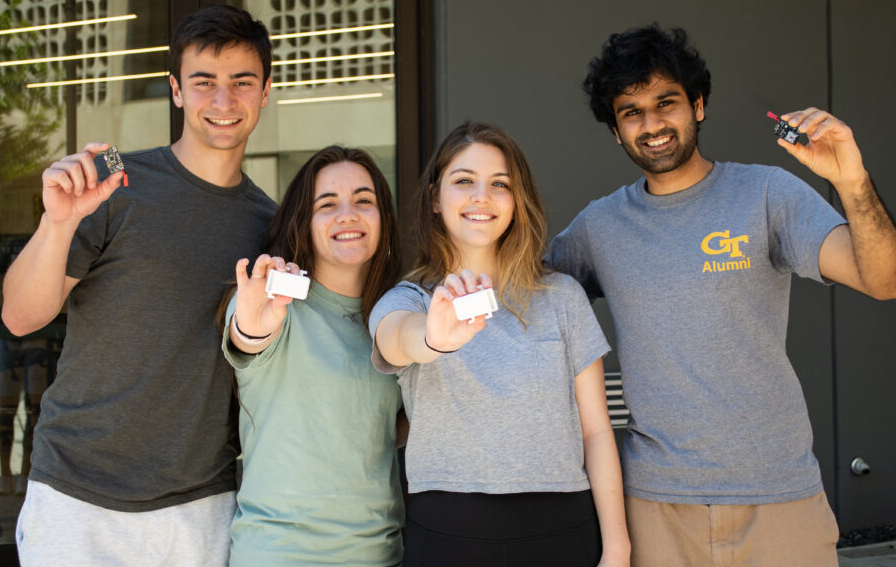Occasionally, even in the medtech innovation industry, stars align for a new technology to quickly, powerfully achieve commercialization and the associated clinical outcomes intended.
Such may well be the case for the team and technology at StrideLink.

As we reported last year, “StrideLink is a new technology venture, a first of its kind wearable gait tracking device, borne from the minds of Georgia Tech alumni Marzeah Khorramabadi (CmpE), Cassandra McIltrot (BME), Neel Narvekar (CmpE) and Tony Wineman (EE).
Over the past 12 months, the team has raised its first, seed-stage funding, refined its business strategy and quality management systems while initiating small batch manufacturing processes required for its physical sensor’s late stage product development.
Primed for success with GCMI support and newly announced remote monitoring CPT codes
All of the team’s work to date, from concept to the technology’s current state, had primed it to seize the opportunity presented by the January 2022 Centers for Medicare and Medicaid Services (CMS) announcement of five new remote therapeutic monitoring CPT codes introduced to cover respiratory and musculoskeletal parameters.”
“Our device and data generating software falls squarely within the technologies covered in the recently announced CMS codes,” StrideLink President & CEO Marzeah (Zea) Khorramabadi said. “A key element of our technology’s value is its cloud-based B2B software rather than a one-time sale of an expensive device. This model lends itself well to the clinical market by enabling low cost initial adoption for our customers, while also enabling us to generate recurring revenue early on. The passage of billing codes that support this business model will incentivize early customers to adopt remote monitoring technologies such as ours. These codes have opened up a new revenue stream for these clinics.”

StrideLink Director of Operations, Research, and Regulatory Cassandra (Cassie) McIltrot
Following on to the early stage development work supported by GCMI through the 2021 CREATE-X program, GCMI has continued to provide development support for the Stridelink team including a “Phase 1” gap analysis, QMS system development to support early stage manufacturing and documentation requirements to ensure an FDA Class listing in 2023 is successful. The partnership is supported through StrideLink’s participation in the Center for MedTech Excellence program.
“The vision for our technology has always been to live in the remote monitoring and data generation space in multiple therapeutic arenas, with physical therapy providers and patients as a launching point,” said StrideLink Director of Operations, Research, and Regulatory Cassandra (Cassie) McIltrot. “Given the recent CMS news, we are working to quickly make our remote monitoring technology available directly to orthopedic clinicians and the patients for which they care.
“We are laser focused on accelerating our timeline on the data generation and software side of the technology.”
Proper sequencing of commercialization activities expands potential for data collection, analysis and dissemination, starting with orthopedic and neurologic applications.
“With the hardware and sensor development work largely complete, the future of our work and technology will be maximizing its ability to collect, analyze and disseminate data for more accurate and efficient predictive diagnostic applications for physical therapy and orthopedics initially with the intention of quickly extending its application into orthopedic surgery, neuro rehabilitation centers and elder care facilities.

Stridelink CTO Neel Narvekar
“With GCMI’s help we are focused on security and compliance in our software systems from the firmware embedded within our first device, to a mobile app and the associated cloud infrastructure required to manage the data,” Zea, who earned her degree in Computer Engineering at Georgia Tech, said. “We are fortunate to have our CTO Neel Narvekar’s experience, coupled with GCMI’s, to understand best practices for those security and compliance systems especially because current regulatory guidance there is still a bit murky. The team fit there should position us for successful compliance positions in light of current and new regulations for the foreseeable future.”
Other upcoming “pre-listing” milestones and team activities include further clinician engagement for clinical evaluation, small batch manufacturing for those clinicians and research partners, both of which will generate user feedback intended to de-risk any future design changes deemed necessary or value-based.
“We are also very happy to announce that thanks in no small part to [GCMI Director of Scientific Affairs] Evan Goldberg’s introduction to the team at the Children’s Hospital Colorado’s Center for Gait and Movement Analysis (CGMA), one of only a handful of nationally accredited clinical motion labs, we are developing an important research partnership to further refine and evaluate our technology,” Zea said.
Initial focus on user and field staff needs creates insights for maximum value potential
When asked what the team has learned or validated since we spoke last year, Cassie said. “Ultimately a new technology needs to be shaped by users’ needs including field staff. The needs and trends we had been uncovering for some time, especially early in our discovery and technology development for remote monitoring in the physical therapy and orthopedic space, has now been substantially validated with the new CMS codes announced earlier this year.”
We feel it bears repeating from our 2021 StrideLink spotlight that, “Establishing best practices early in your startup’s path should increase the likelihood of future success,” Cassie said. “The Silicon Valley mentality does not work for health technology innovation. There are many, many well known stories of startups that met their demise because they failed to understand regulatory requirements early enough, if ever. Enhancing the founding team’ focus on quality, and doing things the right way early will give us a big advantage when it comes to our commercial success potential.”

StrideLink President & CEO Marzeah (Zea) Khorramabadi
Back to the 2022 update, “Most startups don’t consider quality assurance or regulatory strategy and classification early enough in the process,” Zea said. “Yet they have an immense impact on the technology’s design and development pathway. We definitely shifted our mindset on the design team’s impact on successfully delivering our technology to the market, thanks to GCMI’s guidance.”
For many novice medtech innovators, the distinction between building a device and building a company is unclear and frequently needs a binary distinction as early as possible. StrideLink appears to be in the unique position to build both, and more.
“We are building a company with the mission of becoming a new standard for gait analysis. We have become acutely aware that our highest value proposition is in our software and data collection, generation, analysis and dissemination where appropriate.” Zea said. “ We see the potential this technology has to better the lives of many patients while furthering our understanding of gait as a crucial indicator of overall health.”
GCMI proudly supports StrideLink’s ongoing efforts to improve the future of care, including predictive diagnostics, for the musculoskeletal continuum of care and beyond.
If you are interested in learning more about StrideLink’s technology, team and potential, email contact@stridelinkinc.com
Bravo and onward!
